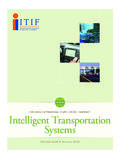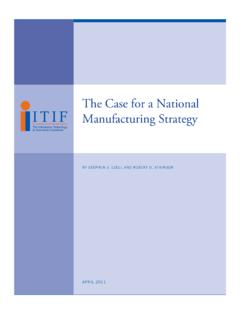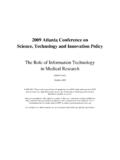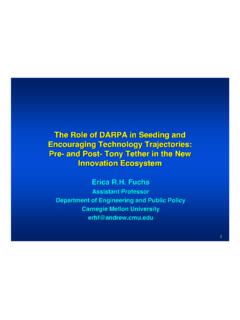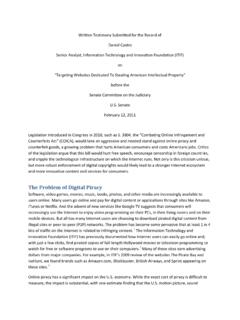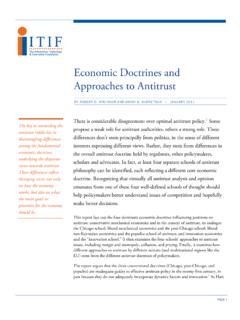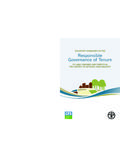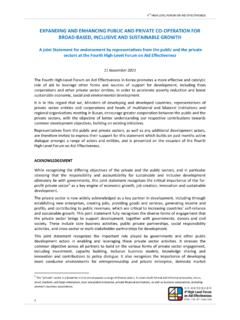Transcription of Benefits and Limitations of Industry Self …
1 Benefits and Limitations of Industry Self-Regulation for Online Behavioral Advertising BY DANIEL CASTRO | DECEMBER 2011. Self-regulation, in all its myriad permutations, is a vital part of today's Policymakers may opt for government regulation of global economy. Diverse industries, such as health care, higher education, privacy when they feel fashion, advertising, mining, marine fishing, professional sports, and that something needs to nuclear power, have used self-regulatory processes to govern Industry be done; however, the practices. 1 The private sector relies on self-regulation to address a range of risk of overregulation is issues, from establishing Industry standards, to developing and applying potentially greater than the risk of under- codes of professional ethics, to ensuring consumer confidence.
2 Despite its regulation. widespread use, some policymakers are skeptical of the efficacy of self- regulation when it comes to protecting consumer privacy online. This report seeks to address that skepticism by explaining how self-regulation works and why it is essential to protecting consumer privacy in online behavioral advertising. TYPES OF REGULATION. Regulatory styles vary considerably from country to country and Industry to Industry . Regulations may set market conditions, such as price controls, market-entry conditions, product requirements and contract terms, or social obligations, such as environmental controls, safety regulations or advertising and labeling requirements. 2 The impact of regulations on the economy depends on the nature of the regulation and how efficiently and effectively it is implemented.
3 While regulations impose costs on firms, causing them to shift resources away from other activities to achieve compliance, these costs are often justified as a means of improving social welfare. For example, the Benefits of regulations to PAGE 1. address concerns about public safety or the environment are intended to outweigh the efficiency cost of imposing the regulations. Regulations, especially if they are performance- based, may also induce innovations that benefit consumers, producers and society. In some instances, regulations may even increase competitiveness by improving the quality of products and services and giving firms that produce these products and services a first- mover advantage.
4 3. While the nature of regulations and the institutions used to create them may vary, as shown in Figure 1, the regulatory process generally consists of three stages: creating regulations, monitoring for compliance, and enforcing regulations. At each of these stages, the level of Industry participation in the regulatory process may vary, from Industry being completely shut out of the process by government to Industry being the leading actor in setting policy. Create Monitor Enforce Regulations Compliance Regulations Figure 1: Three stages of the regulatory process There are a variety of options for government and Industry involvement in the regulatory process, ranging from laissez-faire economies with limited state regulation to tightly managed economies with significant government involvement.
5 As shown in Figure 2, the spectrum of options ranges from non-state regulation to co-regulation to state-based regulation. Non-state regulation involves private, market-based institutions governing their actions through voluntary agreements, peer pressure and other methods to coordinate their actions. Examples of non-state regulation include Industry standards and best practices, professional codes of ethics, and corporate social responsibility. Industry organizations may also engage in self-policing activities to enforce standards internally and among peers. Co-regulation occurs when Industry and government jointly administer the regulatory process. Examples include government watchdog organizations that provide oversight of Industry standards or self-regulatory organizations, government agencies that enforce penalties for violations of self-regulation, and various forms of soft law such as government-issued recommendations, principles or codes of conduct that create a non- binding regulatory framework.
6 4. Finally, state regulation involves government entities regulating the actions of firms in the private sector. Legislation, executive orders and administrative rules issued by government entities are all examples of state regulation. All of these options are alternatives to an absence of any (state or non-state) regulation where firms' behavior is influenced only by the market. 5 The absence of rules does not mean firms are engaging in bad behavior. Many other controls, including social norms, civil litigation, and market forces such as fear of reputational harm, help moderate firm behavior. As FTC Commissioner Julie Brill noted, I can imagine a scenario where someone says 'We respect your privacy and we don't have a program in place,' but they [actually] are respecting your privacy and they're doing a good job.
7 6 Likewise, the presence of rules does not mean that all firms are engaging in THE INFORMATION TECHNOLOG Y & INNOVATION FOUNDATION | DECEMBER 2011 PAGE 2. good behavior, as demonstrated by the behavior of mortgage originators, banks and investment firms during the financial crisis. Non-state State Co-regulation regulation regulation Government Industry watchdogs Legislation standards Executive orders Enforcement Professional agencies Administrative codes of ethics rules Soft law Self-policing Figure 2: State versus non-state regulatory options The distinction between the different types of regulation may blur in practice. Much of what many consider to be self-regulation is in practice co-regulation because of state involvement either in developing rules and standards or in providing a legal backstop for enforcement of self-regulation.
8 HOW SELF-REGULATION WORKS. Self-regulation can be defined as a regulatory process whereby an Industry -level organization (such as a trade association or a professional society), as opposed to a governmental- or firm-level, organization sets and enforces rules and standards relating to the conduct of firms in the Industry . 7 Businesses use self-regulation to decrease risks to consumers, increase public trust, and combat negative public perceptions. It complements existing laws by imposing supplemental rules to govern the behavior of firms. 8 Industries have chosen self-regulation in response to both the absence of government regulation and the threat of excessive government regulation. For example, the Forest Stewardship Council was formed in response to Industry concerns about the lack of government regulation to address the sustainability of natural resources.
9 9 Alternatively, self-regulation may be implemented in response to catastrophic events, such as the formation in the of the Institute of Nuclear Power Operations after the Three Mile Island accident to set power-plant safety guidelines. 10 Self-regulation may even occur in a tightly-regulated Industry . Even under such conditions businesses may still come together to form cooperative agreements to establish Industry standards or best practices. Most of these activities occur through self-regulatory organizations (SROs). SROs are the non-governmental organizations formed by the private sector to set standards, monitor for compliance, and enforce their rules. Some SROs operate with endorsement by government, such as the North American Electric Reliability Corporation (NERC), which is responsible for establishing and enforcing standards for the electric power grid.
10 NERC is certified by the Federal Energy Regulatory Commission, and the Financial Industry Regulatory THE INFORMATION TECHNOLOG Y & INNOVATION FOUNDATION | DECEMBER 2011 PAGE 3. Authority (FINRA), which regulates the securities Industry in the United States with oversight from the Securities and Exchange Commission (SEC). 11 Other examples of SROs include Industry bodies to regulate the use of natural resources, such as the Marine Stewardship Council formed to responsibly manage the global fish stocks. Others include ethics bodies to set guidelines for specific sectors, such as the Distilled Spirits Council of the United States,, which sets advertising standards for alcoholic beverages, and professional associations, such as state bar associations that admit members to the legal profession, and standards organizations.

